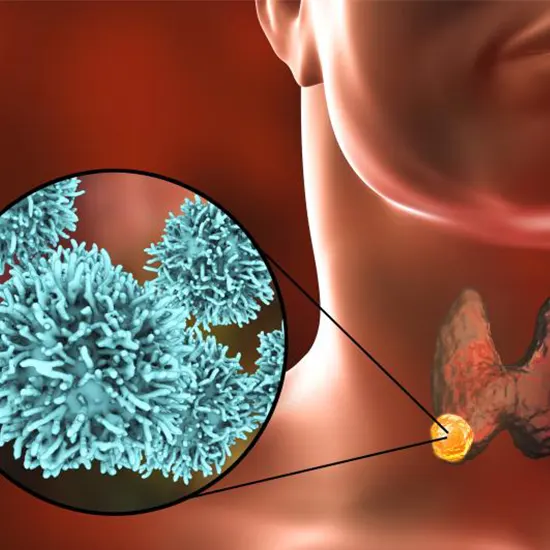
Thyroid cancer is a type of cancer that develops in the thyroid gland, which is located in the neck and produces hormones that regulate metabolism. Thyroid cancer is of several different types such as papillary, follicular,...
Thyroid cancer is a type of cancer that develops in the thyroid gland, which is located in the neck and produces hormones that regulate metabolism. Thyroid cancer is of several different types such as papillary, follicular, medullary, and anaplastic thyroid cancer.
The most common type of thyroid cancer is papillary thyroid cancer, which usually grows slowly and can often be treated successfully with surgery and radioactive iodine therapy. Follicular thyroid cancer is less common and may also be treated with surgery and radioactive iodine therapy. Medullary thyroid cancer is a rare type of cancer that develops from the C cells of the thyroid gland and requires a different treatment approach. Anaplastic thyroid cancer is the most aggressive form of thyroid cancer and is often resistant to treatment.
The symptoms of thyroid cancer may include a lump or swelling in the neck, difficulty swallowing, hoarseness or other voice changes, neck or throat pain, and swollen lymph nodes. In case you experiencing any of these symptoms, it is important to see a doctor for an evaluation. Treatment options for thyroid cancer may include surgery, radioactive iodine therapy, chemotherapy, and targeted therapy. The best course of treatment will depend on the type and stage of cancer, as well as other factors such as the patient's age and overall health.
Types of Thyroid Cancer
Thyroid cancer has various types, which are classified based on the type of cells that are involved in cancer.
The thyroid cancer types are
Papillary thyroid cancer : Papillary thyroid cancer is typical type of thyroid cancer. This cancer type develops from the follicular cells of the thyroid gland. grows slowly compared to other cancer types. It is a highly curable cancer and accounts for around 80% of cases.
Follicular thyroid cancer : This thyroid cancer type also develops from the follicular cells of the thyroid gland. But it is not as common as papillary thyroid cancer. But it tends to be more aggressive and challenging to treat.
Medullary Thyroid Cancer : This type of cancer is often hereditary and develops from the thyroid cells that are known as C cells of the thyroid gland. The role of c cells is to produce the hormone calcitonin. Compared to papillary and follicular thyroid cancer, it is less common.
Anaplastic Thyroid Cancer : This type of thyroid cancer is rare and more aggressive. It has a poor prognosis so it is very difficult to treat as it grows and spread quickly to surrounding tissues and other body parts.
Thyroid lymphoma : This is a rare type of thyroid cancer that develops from the lymphatic tissue in the thyroid gland. It can be either non-Hodgkin's or Hodgkin's lymphoma.
Stages of Thyroid Cancer
Thyroid cancer staging is a way to describe the extent as well as the spread of thyroid cancer. The most commonly used staging system used for staging thyroid cancer is the TNM system, which stands for Tumor size, spread to nearby lymph Nodes, and presence of distant Metastasis.

The TNM staging system for thyroid cancer is as follows
T Stage:
- T1: The tumor is 2 cm or smaller and limited to the thyroid gland.
- T2: The tumor is larger than 2 cm but not larger than 4 cm and limited to the thyroid gland.
- T3: The tumor is larger than 4 cm or has grown outside of the thyroid gland and into nearby structures, such as the larynx, trachea, esophagus, or nerve pathways.
- T4: The tumor has grown into nearby structures such as the muscles, cartilage, or organs.
N Stage:
- N0: No spread to nearby lymph nodes.
- N1a: Cancer has spread to lymph nodes on the same side of the neck as the primary tumor.
- N1b: Cancer has spread to lymph nodes on both sides of the neck or to lymph nodes in the upper chest.
M Stage:
- M0: No distant metastasis.
- M1: Distant metastasis is present, such as in the lungs, bones, or other organs.
- Using this TNM system, the stage of thyroid cancer is determined by combining the T, N, and M stages. The stages are as follows:
Stage I : T1 or T2, N0, M0
Stage II : T1 or T2, N1a, M0; T3, N0 or N1a, M0
Stage III : T3, N1a, M0; T4, any N, M0
Stage IVA : T4, any N, M0; any T, N1b, M0
Stage IVB : any T, any N, M1
The stage of thyroid cancer is important in determining the appropriate treatment plan and predicting the patient's prognosis.
Symptoms of Thyroid Cancer
The symptoms of Thyroid cancer vary depending on the stages and spread of the thyroid cancer. The symptoms may include swelling in the neck, a lump in the neck, difficulty swallowing, hoarseness, or other changes in the voice. Apart from these, you may experience pain in the throat, swollen lymph nodes, etc.
In the initial stages of cancer, thyroid cancer may not cause any signs or symptoms. But it may be discovered during the physical as well as imaging tests. However, the thyroid cancer grows, it develops the symptoms such as:
A lump in the Neck: It is the very first symptom of thyroid cancer. Nodule may be painless and small at the initial stage but over time, it may become painful and larger.
Swollen Lymph Nodes in the Neck: When the thyroid cancer spread to nearby lymph nodes, it makes them become swollen and tender.
Hoarseness or changes in voice: When cancer grows near the vocal cords, it may affect the voice and you may experience changes in the voice.
Difficulty Breathing and swallowing: As cancer spreads, grows, and may press on the windpipe, you may experience difficulty breathing.
Neck or throat pain: Some people with thyroid cancer may experience pain or discomfort in the neck or throat.
Causes of Thyroid Cancer
factors that may increase a person's likelihood of developing thyroid cancer. These risk factors include:
Age: Thyroid cancer can occur at any age, but it is more common in people over the age of 40.
Gender: Women are more likely than men to develop thyroid cancer.
Exposure to radiation: Exposure to radiation, particularly in childhood, increases the risk of developing thyroid cancer.
Family history: Having a first-degree relative (parent, sibling) with thyroid cancer increases the risk of developing the disease.
Certain genetic conditions: Some genetic conditions, such as multiple endocrine neoplasia type 2 and familial medullary thyroid carcinoma, increase the risk of developing thyroid cancer.
Iodine deficiency: A diet low in iodine may increase the risk of developing certain types of thyroid cancer.
Benign thyroid conditions: Some benign thyroid conditions, such as thyroid nodules and goiter, may increase the risk of developing thyroid cancer.
Risk factors of thyroid cancer
It is important to note that having one or more of these risk factors does not necessarily mean that a person will develop thyroid cancer. Many people with thyroid cancer have no known risk factors.

There are several risk factors for thyroid cancer. These risk factors include:
Age: Thyroid cancer is common among individuals of the age group of 40 years or more. But the cancer of thyroid may affect of the individual of any age group.
Gender: Compare to males, females are more likely to develop thyroid cancer.
Radiation Exposure: Exposure to radiation in childhood increases the chance of developing thyroid cancer.
Family History of Thyroid Cancer: Individuals who have family history of thyroid cancer are always at high risk of developing the cancer of thyroid gland.
Certain genetic conditions: Some genetic conditions, such as multiple endocrine neoplasia type 2 and familial medullary thyroid carcinoma, increase the risk of developing thyroid cancer.
Iodine deficiency: A diet low in iodine may increase the risk of developing certain types of thyroid cancer.
Benign thyroid conditions: Some benign thyroid conditions, such as thyroid nodules and goitre, may increase the risk of developing thyroid cancer.
Benefits of early detection of thyroid cancer
Early detection of thyroid cancer has various benefits such as:
Better treatment outcomes: When thyroid cancer is detected at an earlier stage, it is often easier to treat and there is more chance of successful treatment outcome.
More options for treatment: When cancer of the thyroid is diagnosed at an early stage, it allows more and better treatment options to treat and prevent it from spreading.
Reduced cost of healthcare: Early detection of thyroid always reduces the cost of treatment that is associated with the advanced and later staged treatments.
Improved quality of life: At an early stage, thyroid cancer doesn’t impact that much compare to the advanced stage. So, early detection and treatment of the problem help in maintaining the quality of the life.
Reduced risk of complications: If thyroid cancer is left untreated or is detected at a later stage, it may spread to other parts of the body and increase the risk of complications, such as difficulty breathing and swallowing, damage to the vocal cords, and spread to other organs. Early detection and treatment can help reduce these risks.
Diagnosis of Thyroid Cancer
The diagnosis of thyroid cancer involves the combination of different procedures such as medical history, physical evaluation, diagnostic procedures, and biopsy.
Medical history and physical examination: The doctor will ask questions about symptoms, risk factors, and family history, and will perform a physical evaluation to check for any lumps or nodules in the thyroid gland or lymph nodes in the neck.
Blood tests: Blood tests may be used to evaluate thyroid function and to check for any abnormal levels of thyroid hormones or other markers such as thyroid profile test, complete blood count, etc.
Imaging tests: Imaging tests such as Thyroid scans, Thyroid MRI, and whole body pet scans, may be used to evaluate the thyroid gland and surrounding tissues, and to determine the size, location, and characteristics of any nodules or lumps.
Radioiodine Scan: To detect the presence of cancer in the thyroid gland and determine its spread, a radioiodine scan is performed.
Biopsy: A biopsy (fine-needle aspiration) is a definitive test for diagnosing thyroid cancer. A sample of tissue is taken from the thyroid gland using a fine needle and is examined under a microscope for the presence of cancerous cells.
Pathology: If the biopsy reveals the presence of cancerous cells, the sample will be sent to a pathologist who will evaluate the type of cancer and the stage of the disease.
Additional testing: Depending on the results of the initial tests, additional testing may be ordered to further evaluate the extent of the cancer and to determine the best course of treatment.
Conclusion
The diagnosis of thyroid cancer typically involves a combination of medical history, physical examination, imaging tests, and biopsy. Here are the steps involved in diagnosing thyroid cancer. The diagnosis of thyroid cancer is a complex process and may involve multiple tests and evaluations. If you are experiencing any symptoms or have any risk factors for thyroid cancer, it is important to see a doctor for an evaluation.
Ganesh Diagnostic offers the thyroid cancer diagnosis package for detection of thyroid cancer at its early stage. For any query or information regarding the thyroid cancer diagnostic procedures, you can contact our expert healthcare executives 24*7.









